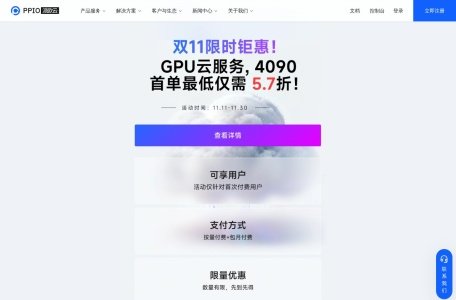
Still worried about the high cost of AI arithmetic, audio and video lag, meta-universe rendering delay, PPIO Paio Cloud gives a one-stop solution – as China’s leading distributed cloud computing service provider, it is built by PPTV founder Yao Xin’s second venture, integrating the world’s 4,000+ arithmetic nodes to provide full-stack services for AI, audio and video, meta-universe and other new-generation scenarios. “Cost-effective, low-latency, ultra-elastic” as the core, for AI, audio and video, meta-universe and other new generation scenarios to provide arithmetic, modeling, edge computing full-stack services, the average daily tokens call volume of more than 150 billion, service 70 million + daily users, become the first choice of the cloud computing partner of China Tower, Baichuan Intelligence and other governmental enterprises. This article combines official information and technical tests to dismantle its core advantages and practical value.
First, the platform positioning: a new generation of scenarios “distributed computing power engine”.
The core mission of PPIO Paio Cloud is to “converge global computing resources to serve global customers”, which is a precise positioning and highly technical barriers:
- Core users: AI developers, enterprise technology teams, audio/video platforms, meta-universe creators, covering the full-scale demand from startups to large-scale governmental enterprises;
- Core value: solving the three major pain points of traditional cloud computing, namely high cost, high latency, and lack of elasticity, and enabling AI, audio/video, and meta-universe scenarios to realize “speed up and cost down” by means of distributed architecture and intelligent scheduling;
- Technical background: PPTV core team built, plowing into distributed computing for more than 10 years, original arithmetic scheduling algorithms, practicing the strategy of “East counts, West counts”, integrating clean arithmetic resources, and forming a sustainable “arithmetic flywheel” ecology.
From AI model inference to virtual concert rendering, from short video distribution to smart hardware networking, PPIO Paio Cloud has become the core infrastructure of the new generation of digital scenarios by virtue of the natural advantages of distributed architecture.
Second, the core function of the actual test: 3 core scenes + 5 technical highlights
1. AI arithmetic service: cost-effective + full-modal model, making AI development more efficient
- Flexible Arithmetic Supply: Provide GPU container instances and Serverless GPUs in two core forms, support NVIDIA RTX and other high-end graphics cards, pay-per-volume and Spot billing as low as 50% off, significantly reducing AI training and reasoning costs.
- Full-modal model API: integrates DeepSeek, Qwen and other mainstream LLM, and multimodal capabilities such as text-generated graphics, video generation, background replacement, etc., compatible with OpenAI API standards, one line of code can be accessed, with a stability of 99.9%.
- Millisecond Response: Relying on the distributed node layout, the real-time arithmetic response is as low as 10ms, supporting model switching and reasoning acceleration in seconds to meet the needs of highly concurrent AI applications.
2. Audio and video solutions: one-stop full link, taking into account the experience and cost.
- Full process coverage: support video upload, storage, transcoding, distribution, playback one-stop service, 8000+ edge nodes to ensure nearby distribution, download speed increased by 50%, lag rate reduced by 80%;
- High Concurrency Adaptation: Support tens of thousands of anchors live online at the same time, can carry sports events, concerts and other heavy security scenarios, service availability of more than 99.9%;
- Multi-terminal compatibility: Adaptation of Android, iOS, H5, small programs and other platforms, support for short and long videos, live broadcasts, real-time audio and video calls and other scenarios, reducing the cost of enterprise technology investment.
3. meta-universe cloud rendering: low latency + high quality, unlocking immersive scenes
- Extreme performance support: Adapt Unreal, Unity3D and other mainstream engines, provide X86/ARM dual-architecture GPU computing power, support ray tracing, AI noise reduction and other high-end rendering features.
- Ultra-low latency interaction: Based on HARQ anti-weak network technology, the rendering latency is as low as 20ms, which realizes smooth control and avoids lagging and splash screen in a weak network environment.
- All-platform access: support for cell phones, PC, TV, VR and other terminals, you can quickly build virtual launch, online exhibition, cloud games and other meta-universe scenarios, second deployment instances.
4. General technology highlights: the natural advantages of distributed architecture
- Global node layout: 4,000+ distributed computing nodes covering 1,300+ county-level regions, 20+ intelligent computing centers linked to achieve “nearby service” and reduce network latency;
- Intelligent scheduling algorithms: dynamic allocation of computing resources, load balancing to avoid node overload, flexible scaling to adapt to unexpected demand, and unlimited expansion of multi-million-core clusters;
- Security and stability guarantee: multi-layer security measures to protect data privacy, 24/7 professional engineer services, support for private deployment and customized solutions;
- Low-threshold access: provide standardized API and SDK, supporting detailed documentation and technical support, novice can also quickly complete the deployment, without having to pay attention to the underlying operations and maintenance.
Typical application scenarios: “arithmetic base” for digital upgrading of the whole industry.
1. AI industry
- Developers rapidly deploy large model applications without the need to build their own computing power clusters, reducing costs by 60%;
- Enterprises build intelligent customer service and content generation systems, and realize rapid iteration through full-modal APIs to seize market opportunities.
2. audio/video and live broadcasting
- Short video platform realizes local uploading and distribution, increasing loading speed by 30% and reducing bandwidth cost by 40%;
- Educational institutions build interactive live classrooms with real-time audio and video call latency as low as 20ms, ensuring teaching experience.
3. Meta-universe and virtual scene
- Cultural tourism industry to create online virtual exhibition hall, support 10,000 people at the same time online immersive tour, rendering costs reduced by 50%;
- Entertainment companies hold virtual concerts, relying on high concurrency rendering and low latency streaming to realize real-time interaction between the audience and the stage.
4. Government, enterprises and scientific research
- China Tower has built a national arithmetic scheduling platform and accessed eight nodes of smart computing resources to serve science parks, smart communities and other scenarios;
- Colleges and research institutions utilize elastic computing power to accelerate AI model training and experimental data processing, shortening the research cycle.
Core differences with similar cloud computing products
| Comparison Dimension | PPIO Paio Cloud | Traditional centralized cloud computing (e.g., Aliyun/Tencent Cloud) | Niche Edge Computing Service Providers |
|---|---|---|---|
| Core Architecture | Distributed nodes + intelligent scheduling | Centralized data center | Localized edge nodes with limited coverage |
| Latency Performance | Millisecond level (10-20ms) | Hundred milliseconds | Low latency but lack of stability |
| Cost-effective | Spot billing 50% off, pay per volume without waste | High cost of long-term use, inflexible billing is not flexible | High price, limited arithmetic scale |
| Scenario Adaptation | Deeply adapted to AI/audio/video/meta-universe | General-purpose scenarios, insufficient special optimization | Single scene focus, weak compatibility |
| Node Coverage | 4000+ global nodes, 1300+ county-level coverage | Core city nodes, insufficient sinking | Regionalized nodes, weak cross-region capability |
Data source: Comparison between official disclosure and actual measurement in November 2025
V. Suggestions for use: a guide to efficiently getting started and avoiding pitfalls
- Scenario matching: AI development prioritizes Serverless GPUs + model APIs to quickly validate ideas; audio and video platforms directly adopt one-stop solutions to reduce self-research costs.
- Cost control: use Spot billing for non-core business, choose monthly packages for long-term stable demand, and further reduce costs by combining the “East Counts West Counts” node.
- Technology selection: GPU container instances for high concurrency rendering, Serverless GPUs for lightweight AI applications, and low-latency node regions for meta-universe scenarios.
- Enterprise cooperation: large-scale government and enterprises can apply for private deployment and customized scheduling solutions, with 7 × 24 hours of engineer services to ensure business stability.
Summarize: a new generation of cloud computing “cost reduction and efficiency” benchmarks
PPIO Paio Cloud has become a “differentiated player” in the field of cloud computing by virtue of the natural advantages of distributed architecture, the technical accumulation of the core team, and the deep adaptation to the new generation of scenarios. It not only solves the arithmetic pain points of AI, audio/video, and meta-universe scenarios, but also promotes technological universality through “speed up and fee reduction”, so that more enterprises and developers can access cutting-edge technologies at low cost.
Whether it is AI startups saving computing power costs or large enterprises building distributed business architecture, PPIO Paio Cloud can provide precisely adapted solutions. Now you can consult the business through the official website to get customized solutions and test credits!
Relevant Navigation


NewDakou

NewMiaoDa

n8n

HaiSnap

NewCREAO

FastGPT

NewTrickle AI

